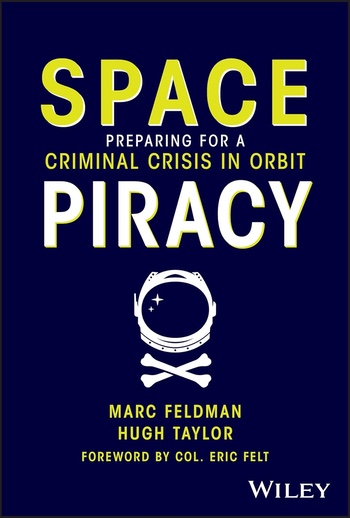Review: Space Piracyby Jeff Foust
|
| They consider other forms of piracy that range from stealing cargo in space or on its return to Earth to threatening to destroy space hardware to even seizing crewed facilities in space. |
Space cybersecurity is a concern, although very little of it would be considered piracy even by the authors: they differentiate space hacking from space piracy by arguing the latter requires a ransom demand. And they acknowledge that hacking a satellite, for profit or other motivations, is more difficult that going after terrestrial networks. That was the case three years ago when Russia, at the start of its invasion of Ukraine, disrupted satellite communications provided by Viasat’s KA-SAT satellite not by going after the satellite but instead hacking routers on the ground.
Cyberattacks are not the only forms of piracy considered in the book. They consider other forms of piracy that range from stealing cargo in space or on its return to Earth to threatening to destroy space hardware to even seizing crewed facilities in space (see “What will happen in the first space hostage crisis?”, The Space Review, September 23, 2024.) Most of these, they admit, are well in the future—very little cargo is being returned from space now—but they argue could become more realistic in the future if the space economy meets growth forecasts some have projected for the industry.
The authors include some scenarios of various space piracy incidents they foresee happening. However, in some cases the scenarios don’t hold up to scrutiny. One is where a major network is warned, 24 hours before it broadcasts a major sporting event, that pirates have placed a nanosatellite next to the one that network will be using, and will use it to jam transmissions unless paid a “huge ransom.” That scenario requires the reader to believe that a pirate group could develop and launch a satellite, then maneuver it undetected next to the company’s satellite. Even if they did, the broadcaster—which almost certainly is leasing satellite capacity from a major operator like Eutelsat or Intelsat—could simply switch to another satellite, using backup plans it would already have in place in case of ordinary technical difficulties.
Similarly, elsewhere in the book the authors suggest that the collapse of companies that struggled to develop launch vehicles “make these companies easy targets for criminals intent on getting into space.” But they don’t explain how criminals would do that, given how highly regulated launch is and the significant export controls that govern launch technologies. Foreign investment in such companies is subject to major scrutiny and getting approvals to export a launch vehicle to even a close ally like Australia or the United Kingdom is challenging.
Nonetheless, it’s better to be thinking about such problems too early than too late. Space Piracy, at the very least, opens the readers’ eyes to the potential for the types of criminal behavior that might be possible in a future where the space economy is booming and access to space approaches the cost and convenience of maritime transport. One can even imagine a future at, say, the lunar south pole, where the discovery of scarce and valuable frozen volatiles tempts some to steal them. You could call them ice pirates.
Note: we are now moderating comments. There will be a delay in posting comments and no guarantee that all submitted comments will be posted.
